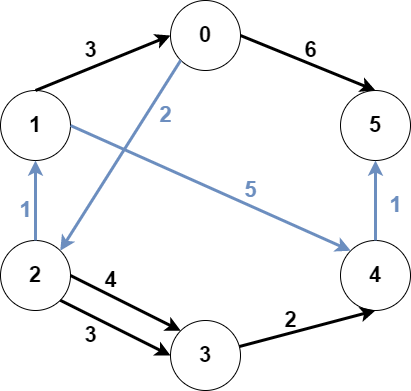- {x}
- Append K Integers With Minimal Sum
- Create Binary Tree From Descriptions
- Replace Non-Coprime Numbers in Array
- Number of Single Divisor Triplets
- Finding the Topic of Each Post
- Find All K-Distant Indices in an Array
- Count Artifacts That Can Be Extracted
- Maximize the Topmost Element After K Moves
- Minimum Weighted Subgraph With the Required Paths
- Distance to a Cycle in Undirected Graph
- The Number of Users That Are Eligible for Discount
- Divide Array Into Equal Pairs
- Maximize Number of Subsequences in a String
- Minimum Operations to Halve Array Sum
- Minimum White Tiles After Covering With Carpets
- Count Hills and Valleys in an Array
- Count Collisions on a Road
- Read More...

Minimum Weighted Subgraph With the Required Paths
You are given an integer n denoting the number of nodes of a weighted directed graph. The nodes are numbered from 0 to n - 1.
You are also given a 2D integer array edges where edges[i] = [fromi, toi, weighti] denotes that there exists a directed edge from fromi to toi with weight weighti.
Lastly, you are given three distinct integers src1, src2, and dest denoting three distinct nodes of the graph.
Return the minimum weight of a subgraph of the graph such that it is possible to reach dest from both src1 and src2 via a set of edges of this subgraph. In case such a subgraph does not exist, return -1.
A subgraph is a graph whose vertices and edges are subsets of the original graph. The weight of a subgraph is the sum of weights of its constituent edges.
Example 1:

Input: n = 6, edges = [[0,2,2],[0,5,6],[1,0,3],[1,4,5],[2,1,1],[2,3,3],[2,3,4],[3,4,2],[4,5,1]], src1 = 0, src2 = 1, dest = 5 Output: 9 Explanation: The above figure represents the input graph. The blue edges represent one of the subgraphs that yield the optimal answer. Note that the subgraph [[1,0,3],[0,5,6]] also yields the optimal answer. It is not possible to get a subgraph with less weight satisfying all the constraints.
Example 2:

Input: n = 3, edges = [[0,1,1],[2,1,1]], src1 = 0, src2 = 1, dest = 2 Output: -1 Explanation: The above figure represents the input graph. It can be seen that there does not exist any path from node 1 to node 2, hence there are no subgraphs satisfying all the constraints.
Constraints:
3 <= n <= 1050 <= edges.length <= 105edges[i].length == 30 <= fromi, toi, src1, src2, dest <= n - 1fromi != toisrc1,src2, anddestare pairwise distinct.1 <= weight[i] <= 105
Solution Explanation for Minimum Weighted Subgraph With the Required Paths
This problem asks to find the minimum weight of a subgraph such that we can reach a destination node (dest) from two source nodes (src1 and src2). The solution uses Dijkstra's algorithm to efficiently find shortest paths in the graph.
Approach
-
Graph Representation: The input
edgesis transformed into an adjacency list representation of the directed graph. We create two adjacency lists:grepresenting the original graph andrgrepresenting the reversed graph (edges are flipped). The reversed graph is crucial for efficiently finding shortest paths fromdestto other nodes later. -
Dijkstra's Algorithm: We employ Dijkstra's algorithm three times:
- Once from
src1to all other nodes usingg. - Once from
src2to all other nodes usingg. - Once from
destto all other nodes usingrg(this finds shortest paths todest).
- Once from
-
Minimum Weight Calculation: For each node
i, we sum the shortest path distances fromsrc1toi,src2toi, anditodest. The minimum of these sums represents the minimum weight subgraph satisfying the conditions. This is because the sum represents the total weight of edges involved in paths fromsrc1andsrc2todestgoing through nodei. -
Handling Infeasible Cases: If any of the Dijkstra's computations result in an infinite distance (meaning a node is unreachable), we mark the result as
-1.
Time and Space Complexity
-
Time Complexity: O(E log V), where E is the number of edges and V is the number of vertices. This is dominated by the three Dijkstra's algorithm runs. Each run of Dijkstra's algorithm takes O(E log V) time using a min-heap priority queue.
-
Space Complexity: O(V + E), primarily used to store the adjacency lists (
gandrg).
Code (Python and Java)
The Python and Java code implementations closely follow the approach described above. Key data structures used include:
defaultdict(list)(Python) orList<Pair<Integer, Long>>[](Java) for the adjacency list graph representation.Pairis a custom class in Java to represent edges (vertex, weight).heapq(Python) orPriorityQueue(Java) for efficient implementation of Dijkstra's algorithm using a min-heap.
The code efficiently finds the minimum weight subgraph by leveraging the properties of Dijkstra's algorithm and considering all possible intermediate nodes. The handling of unreachable nodes ensures correct output even in cases where the required paths do not exist.